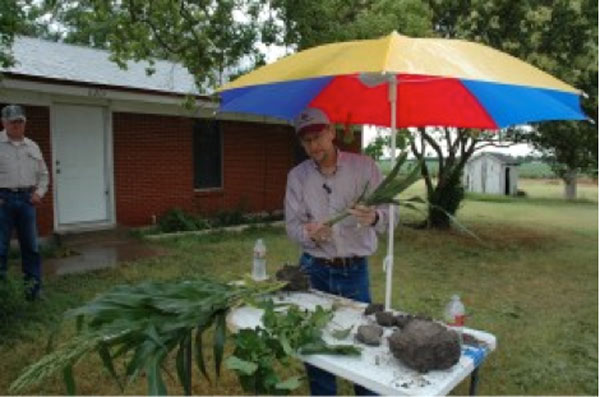July 11, 2013

Increasing soil organic matter, reducing tillage and paying attention to axle loads were just a few of the tips a soil expert shared with Blacklands farmers at the recent Stiles Farm Field Day.
Dr. Mark McFarland, a regents professor and Texas A&M AgriLife Extension Service state soil fertility specialist, provided an overview of soils in the Blacklands region and methods to maintain high soil quality.
McFarland said soil clods are important as they play a key role in the movement of air and water into a soil.
“These small, dime- to BB-size clods are critical because they change the porosity of the soil,” he said. “When soil particles come together and form clods, the spaces between the particles get larger. This allows a loam or clay soil to act more like a sand in terms of air and water movement into that soil.”
He said this interaction of soil particles is “critical to our crops.”
“When you look at a bare piece of ground and see a flat surface, that tells you that you don’t have good soil surface structure,” McFarland said. “It indicates that all the clods have fallen apart or been crushed. Now all of the sand, silt and clay particles are acting as individuals.”
McFarland said silt and sand particles have a round shape, but clay particles are flat. When clay comes loose from a clod and settles on the ground after a rainfall, it will layer to form a soil crust. Surface soil crusts can be major barriers to air and water movement into the soil.
“It’s also a barrier to seedling emergence,” he said. “So, you could have problems with crop stand establishment if surface soil structure is poor.”
McFarland said the most important ingredient in a soil clod is organic matter.
Soil microbes decompose organic matter which forms humus. Humus is the glue of the soil; it sticks soil particles together to form clods. So, organic matter is critical to have good soil structure.
Crop residues provide organic matter, and crops that produce higher amounts of residue should be included in a rotation, especially following silage removal or crops such as cotton that produce little organic matter, he said.
If you are enjoying reading this article, please check out Southwest Farm Press Daily and receive the latest news right to your inbox.
“Organic amendments like compost and manure also can be good sources of organic matter,” McFarland said. “When there is limited risk of depleting soil moisture, cover crops are an excellent way to boost soil organic matter levels.”
And a legume cover crop, like clover, vetch, cowpeas or medics, will fix nitrogen from the atmosphere for the next crop and could save farmers money over the long haul.
“Another thing we need to do is minimize tillage,” he said. “These old Blacklands soils originally had organic matter levels between eight and 10 percent. After 150 years of farming, we are down to less than 3 percent organic matter. Tillage has played a big role in that. When we till the soil, it’s pretty much like stoking a fire. We break that organic matter up and mix it down into the soil where there is more soil moisture.”
McFarland said those soil microbes are working all the time down where there is moisture, and organic matter is their breakfast, lunch and dinner.
“While they do produce humus, which is good, another part of decomposition is soil respiration by those microbes. That’s when part of the organic matter is lost from the soil as carbon dioxide.”
McFarland said reducing tillage and leaving crop residue on the soil surface slows the decomposition process down. It also helps protect surface soil structure.
“When larger raindrops fall from the sky, they’re coming down at about 30 feet per second. If they hit bare soil, it’s like a hammer hitting the ground. You’ve seen the soil splash up high on your tractor tire. That impact can do a lot of damage to soil structure if it’s not protected.”
A good residue cover will intercept the raindrops, protect the soil surface and get more infiltration with less evaporation, he said.
In general, McFarland said to limit trips across the field.
“The less time you spend in the field with that equipment the better it is for your soil,” he said. “Another thing to look at is using controlled traffic patterns; follow the same wheel tracks every time. That limits the percentage of the field that will see any compaction. And, try to reduce axle loads or increase the number of axles when possible to lower the compressive force on the soil. Our management can have major impacts on soil quality, and if we manage it well, it will pay us back in terms of a healthy soil and a productive crop.”
You may also like:
50th Stiles Farm Field Day honors past, looks to future
Stiles Farm Field Day celebrates 50 years
Saving the lives of one billion people: guest editorial
You May Also Like




